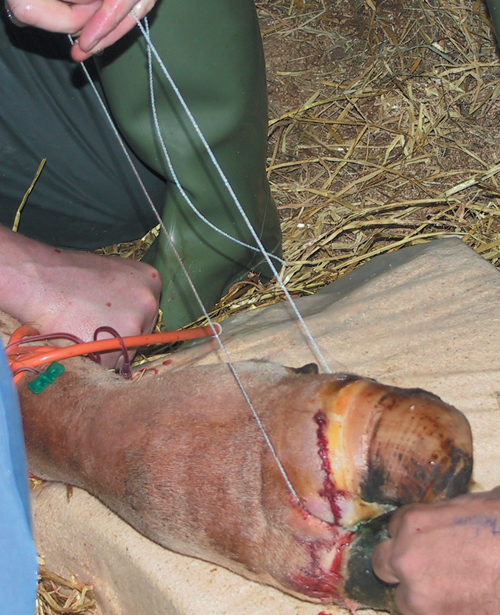Difference between revisions of "Cattle Medicine Q&A 02"
(Created page with "{{Template:Manson}} centre|500px <br /> '''A Limousin bull presents with severe (10/10) lameness of the left pelvic limb with marked muscle atr...") |
|||
| (4 intermediate revisions by 2 users not shown) | |||
| Line 1: | Line 1: | ||
| − | {{Template:Manson | + | {{Template:Manson}} |
[[Image:Cattle Medicine 2.jpg|centre|500px]] | [[Image:Cattle Medicine 2.jpg|centre|500px]] | ||
| Line 11: | Line 11: | ||
|q1=Describe the method of analgesia you would employ for the procedure illustrated here | |q1=Describe the method of analgesia you would employ for the procedure illustrated here | ||
|a1= | |a1= | ||
| − | The procedure shown is digit amputation under intravenous regional anaesthesia. Flunixin meglumine (or other NSAID) is injected intravenously before surgery. A robust tourniquet is placed below the hock and 30–40 mL of 2% lidocaine | + | The procedure shown is digit amputation under intravenous regional anaesthesia. Flunixin meglumine (or other NSAID) is injected intravenously before surgery. A robust tourniquet is placed below the hock and 30–40 mL of 2% lidocaine solution is injected into the superficial vein running on the cranio - lateral aspect of the third metatarsal bone (butterfly catheter shown in situ). Analgesia is effective within 2 minutes. |
| − | |l1= | + | |l1=Bovine_Anaesthesia#Intravenous_Regional_Blocks |
|q2=How would you complete the procedure shown? | |q2=How would you complete the procedure shown? | ||
|a2= | |a2= | ||
| Line 18: | Line 18: | ||
<br> | <br> | ||
If infection in the deep flexor tendon sheath has extended above the amputation site, 10–15 cm of flexor tendon can be removed to effect drainage. | If infection in the deep flexor tendon sheath has extended above the amputation site, 10–15 cm of flexor tendon can be removed to effect drainage. | ||
| − | |l2= | + | |l2= |
</FlashCard> | </FlashCard> | ||
| − | |||
| − | |||
| − | |||
| − | |||
| − | |||
| − | |||
| − | |||
| − | |||
| − | |||
| − | |||
| − | |||
| − | |||
| − | |||
| − | |||
| − | |||
{{#tag:imagemap|Image:Next Question.png{{!}}center{{!}}200px | {{#tag:imagemap|Image:Next Question.png{{!}}center{{!}}200px | ||
Revision as of 18:09, 12 April 2011
| This question was provided by Manson Publishing as part of the OVAL Project. See more [[:Category:{{{book}}}|{{{book}}}]]. |
A Limousin bull presents with severe (10/10) lameness of the left pelvic limb with marked muscle atrophy over the left hip. The left hindfoot is swollen with marked widening of the inter - digital space. There is loss of hair and thinning of the skin extending all around the coronary band of the lateral claw extending proximally for 3 cm with a discharging sinus consistent with septic pedal arthritis.
| Question | Answer | Article | |
| Describe the method of analgesia you would employ for the procedure illustrated here | The procedure shown is digit amputation under intravenous regional anaesthesia. Flunixin meglumine (or other NSAID) is injected intravenously before surgery. A robust tourniquet is placed below the hock and 30–40 mL of 2% lidocaine solution is injected into the superficial vein running on the cranio - lateral aspect of the third metatarsal bone (butterfly catheter shown in situ). Analgesia is effective within 2 minutes. |
Link to Article | |
| How would you complete the procedure shown? | The interdigital skin is incised as close to the infected tissue as possible and the incision extended for the full length of the interdigital space to a depth of 2 cm cranially increasing to 4 cm caudally. A length of embryotomy wire is introduced into the incision and the lateral digit removed at the level of mid P2 (wire at 15° to horizontal). A melolin dressing (or similar) is applied to the wound then cotton wool and a pressure bandage applied using Elastoplast (or similar). The dressing is changed after 4 days. The bull made a full recovery and is still in the herd 18 months later.
|
[[|Link to Article]] | |
